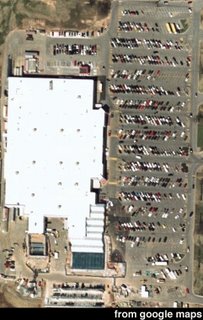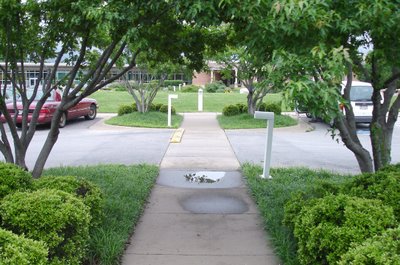Can Parking Be A Pleasure?
A few weeks ago, I had to go to the Jones Center for Families in Springdale for one of the light rail forums, which I'll hopefully be sharing more about later. For those of you who live in NWA, believe it or not, I'd never been to the Jones Center before. So I pulled into the parking lot, running late because of work, and rolled around looking for a parking place. As per my usual routine, I just went straight to the back of the parking lot because I LOATHE spending any amount of time looking for the closest space possible. I'd much rather park in the shade a mile away, or just park at the first available spot and enjoy the walk.
When I got out of my truck, I noticed that the divider between the lines of parking couldn't be walked over. It was full of trees and bushes. This was not a problem, though, because by walking just 25 yards or so to either side, you found one of these wonderful walkways leading to the front door of the Jones Center:
 The parking lot was laid out like a rainbow, with the building sitting sort of under the rainbow. So no matter where you parked, you had a pleasant walk on a sidewalk under a tree canopy to get to the front door. Jones Center aerial at left
The parking lot was laid out like a rainbow, with the building sitting sort of under the rainbow. So no matter where you parked, you had a pleasant walk on a sidewalk under a tree canopy to get to the front door. Jones Center aerial at left
It got me to thinking; why does it have to work out so that by virtue of having a large parking lot, it has to be the most unpleasant thing to navigate on foot to wherever you were going? If Wal-Mart's parking lots were laid out like this, I certainly wouldn't dread going to WM. (But I'd still prefer walking to Harps downtown) The parking lot can be a pain to navigate, and once I get out of my car, since I don't spend 30 minutes looking for the closest space, I have a fairly boring walk across acres of asphalt, dodging errant shopping carts and clueless drivers on the hike to the door. Store #100 in Bentonville below
Can't they (and everyone else) do better?
A lot of planning experts (including Planning Works, which is consulting with Bentonville for our General Plan) will tell you that you get exactly what you ask for. If you have no standards for retail development in your city, then you get the cheapest, simplest, most cost-effective building from national retailers. And you better bet that they're not going to spend any more money on trees or other design "extras" than the city's codes call for.
I'm going to Hilton Head (SC) in a few weeks, and it's a wonderful example of what good standards can do for a place. Everything looks so unobtrusive. Without getting into a lot of the specifics, parking lots have to have lots of trees, signs can only be made out of wood and are size-restricted, and sidewalks and bike paths are everywhere, including at the shopping centers. It can be hard to even see how big a parking lot is because you can't see all of it for the trees. It's almost like there's a tree canopy mandated everywhere. (I'll try to shoot some pictures while I'm there.)
It's a good lesson to remember as we're coming up on the next General Plan meeting pretty soon. As citizens here, we shouldn't be afraid to demand exactly what we want here. This market is continuing to grow, so no one should be afraid of pushing developers away because of standards. And if you push developers away who don't want to build what meets our standards, isn't that a good thing?
On another note, doesn't it seem like it would be in the best interest of developers or retailers like Wal-Mart to try making parking lots like the Jones Center? You probably sacrifice a number of spots to do that, and it's more expensive, but wouldn't it make shopping there so much more enjoyable? It's ironic that the parking lot at the "green" Wal-Mart in McKinney, Texas, is basically just the same as the others, albeit with a random windmill in the middle of it.
They provide a space to put your car; wouldn't it seem like common sense to provide a nice path for those shoppers to get from their car to your store and back?
Kudos the Jones Center for making a parking lot that is actually enjoyable to use.
(two more of the view at the Jones Center)

read more: photos, parking, sidewalks, sprawl, wal-mart, development



|